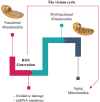Reactive Oxygen Species: the Dual Role in Physiological and Pathological Conditions of the Human Body
- PMID: 30515042
- PMCID: PMC6263229
- DOI: 10.5152/eurasianjmed.2018.17397
Reactive Oxygen Species: the Dual Role in Physiological and Pathological Conditions of the Human Body
Abstract
Reactive oxygen species (ROS) are well-known for playing a dual role as destructive and constructive species. Indeed, ROS are engaged in many redox-governing activities of the cells for the preservation of cellular homeostasis. However, its overproduction has been reported to result in oxidative stress, which is considered as a deleterious process, and is involved in the damage of cell structures that causes various diseased states. This review provides a concise view on some of the current research published in this topic for an improved understanding of the key roles of ROS in diverse conditions of health and disease. Previous research demonstrated that ROS perform as potential signaling molecules to control several normal physiological functions at the cellular level. Additionally, there is a growing body of evidence supporting the role of ROS in various pathological states. The binary nature of ROS with their profitable and injurious characteristics indicates the complexities of their specific roles at a biological compartment and the difficulties in establishing convenient intervention procedures to treat ROS-related diseases.
Keywords: Reactive oxygen species; cancer; free radicals; infertility; oxidative stress.
Conflict of interest statement
Conflict of Interest: Authors have no conflicts of interest to declare.
Figures




References
-
- Lasségue B, San Martin A, Griendling KK. Biochemistry, physiology, and pathophysiology of NADPH oxidases in the cardiovascular system. Circ Res. 2012;110:1364–90. https://doi.org/10.1161/CIRCRESAHA.111.243972 - DOI - PMC - PubMed
-
- Izyumov D, Domnina L, Nepryakhina O, et al. Mitochondria as source of reactive oxygen species under oxidative stress. Study with novel mitochondria-targeted antioxidants—the “Skulachev-ion” derivatives. Biochemistry (Mosc) 2010;75:123–9. https://doi.org/10.1134/S000629791002001X - DOI - PubMed
-
- Cubero FJ, Nieto N. Arachidonic acid stimulates TNFα production in Kupffer cells via a reactive oxygen species-pERK1/2-Egr1-dependent mechanism. Am J Physiol Gastrointest Liver Physiol. 2012;303:G228–G39. https://doi.org/10.1152/ajpgi.00465.2011 - DOI - PMC - PubMed
-
- Davies BW, Kohanski MA, Simmons LA, Winkler JA, Collins JJ, Walker GC. Hydroxyurea induces hydroxyl radical-mediated cell death in Escherichia coli. Mol Cell. 2009;36:845–60. https://doi.org/10.1016/j.molcel.2009.11.024 - DOI - PMC - PubMed
-
- Nishikawa T, F Sato E, Choudhury T, et al. Effect of nitric oxide on the oxygen metabolism and growth of E. faecalis. J Clin Biochem Nutr. 2009;44:178. https://doi.org/10.3164/jcbn.08-235 - DOI - PMC - PubMed
Publication types
LinkOut - more resources
Full Text Sources
Other Literature Sources
Molecular Biology Databases
